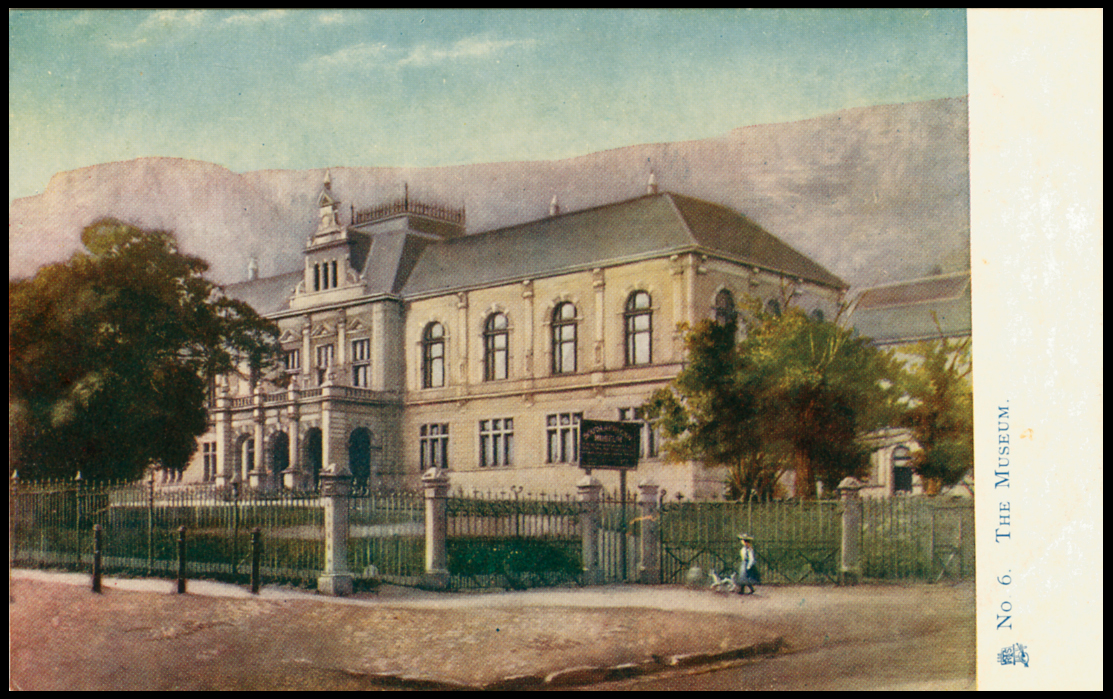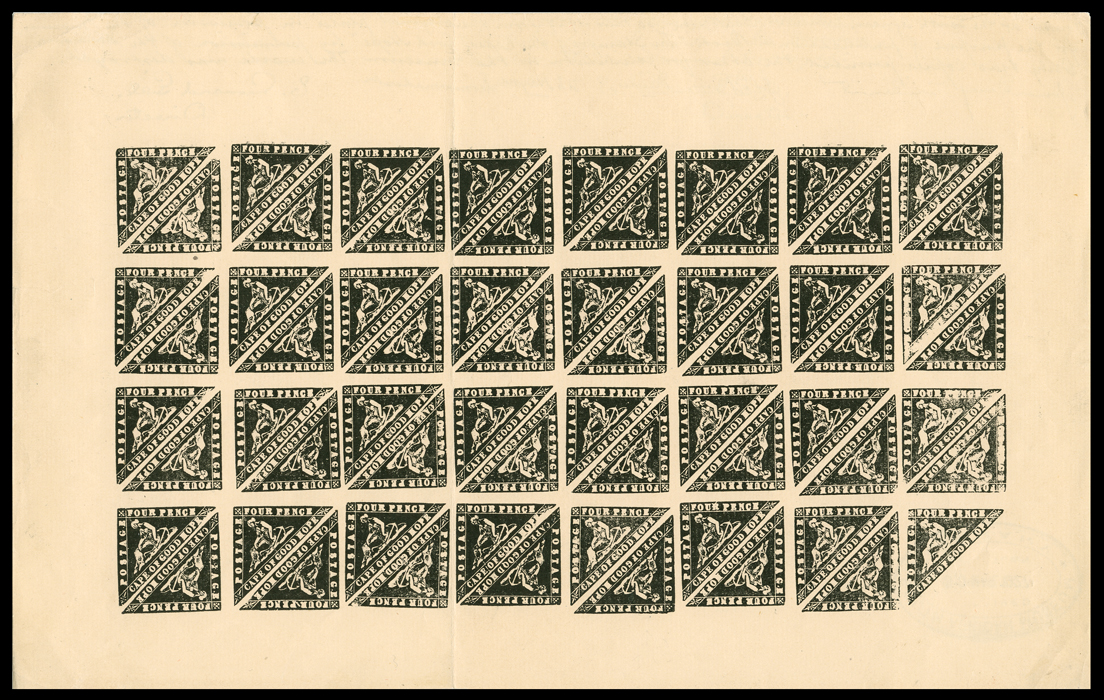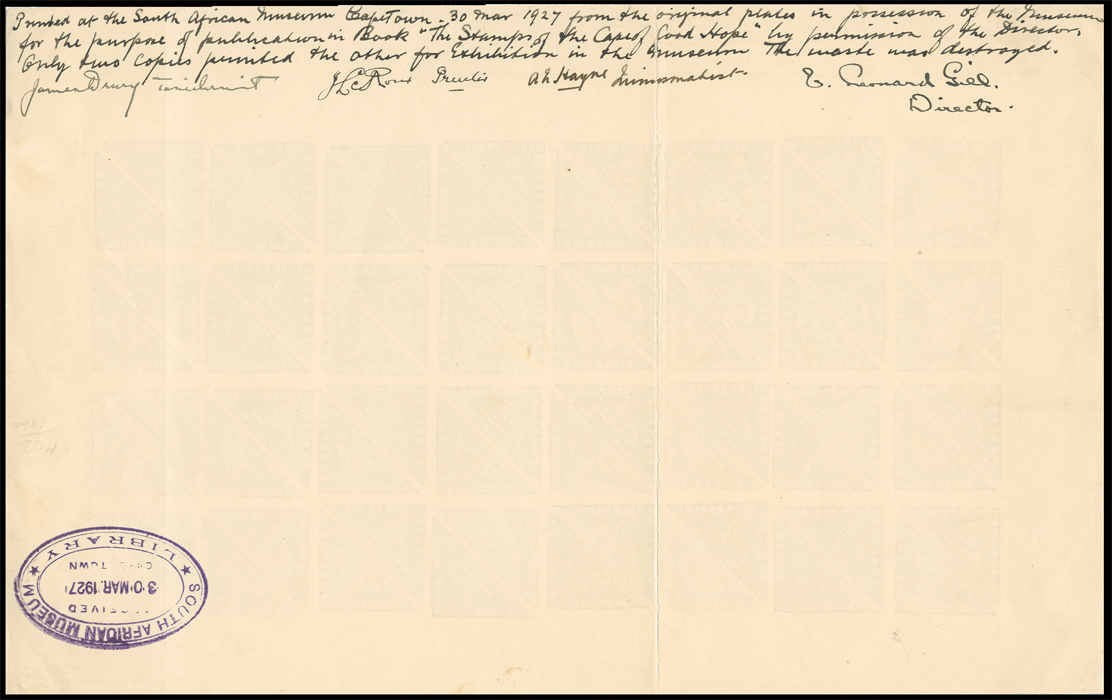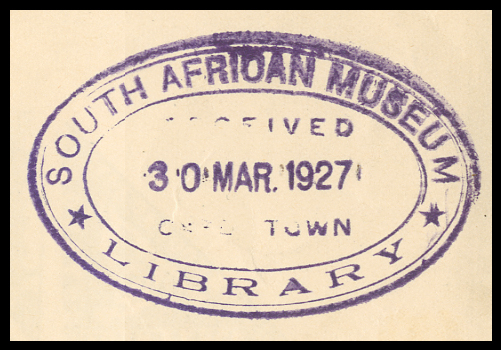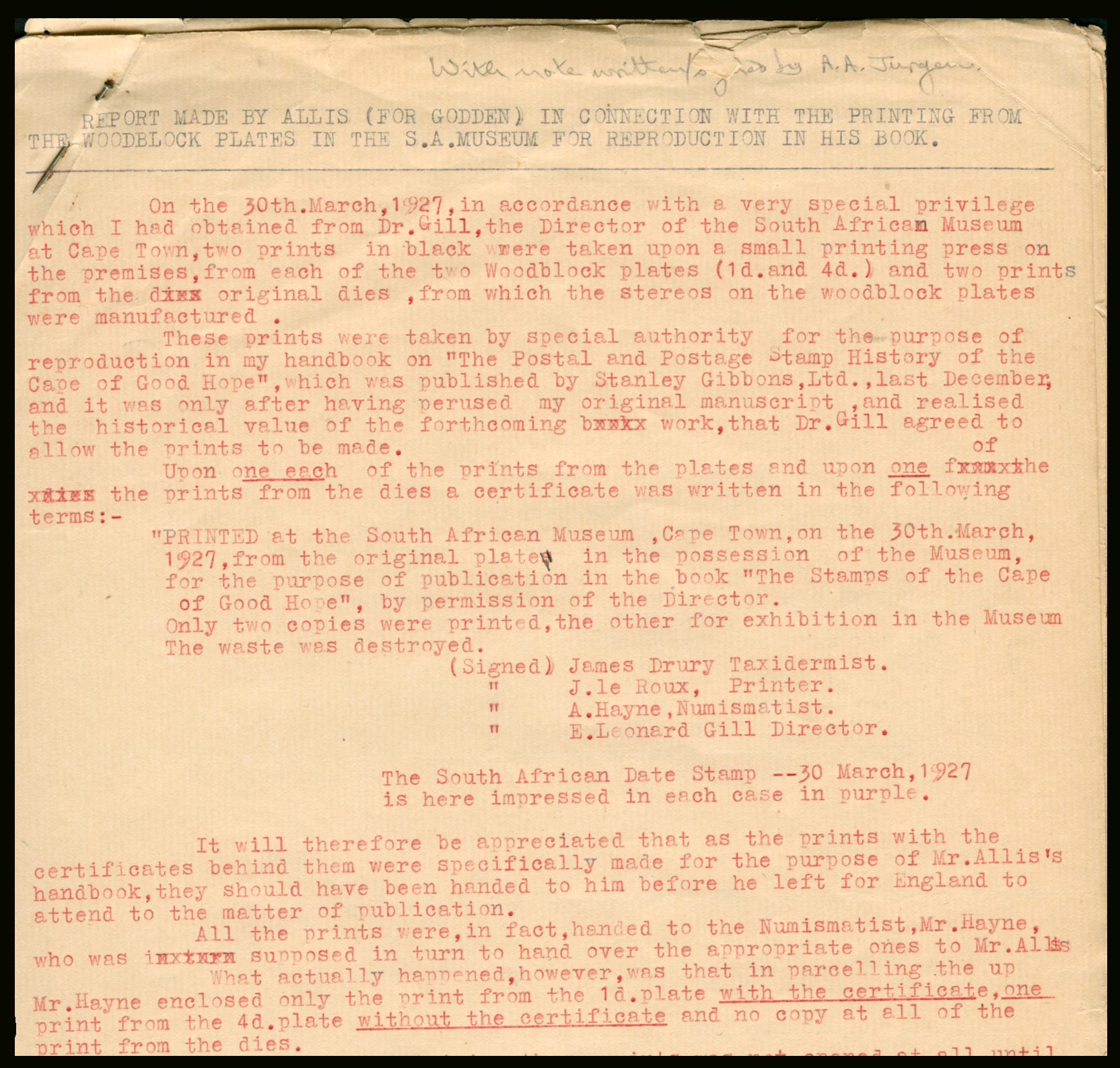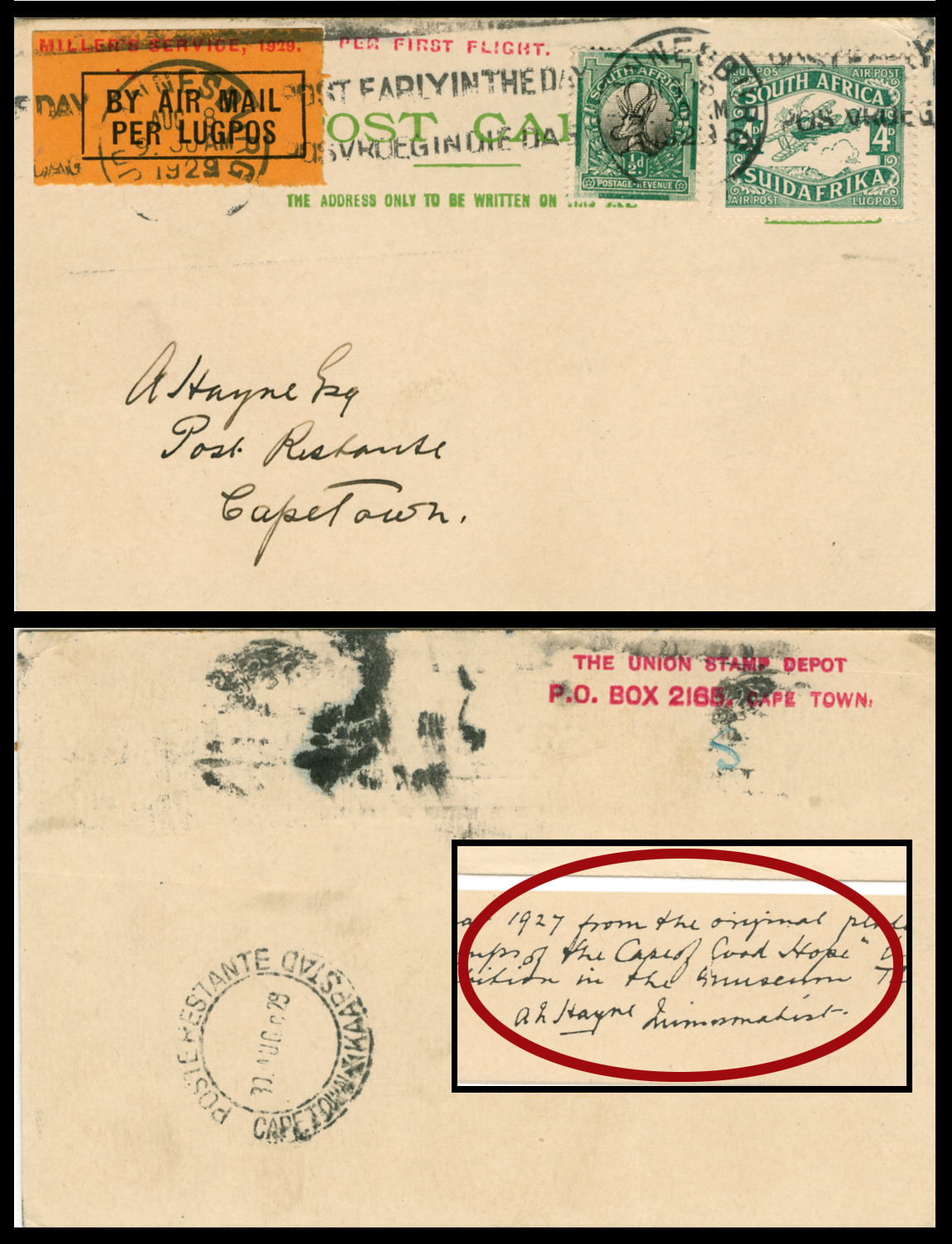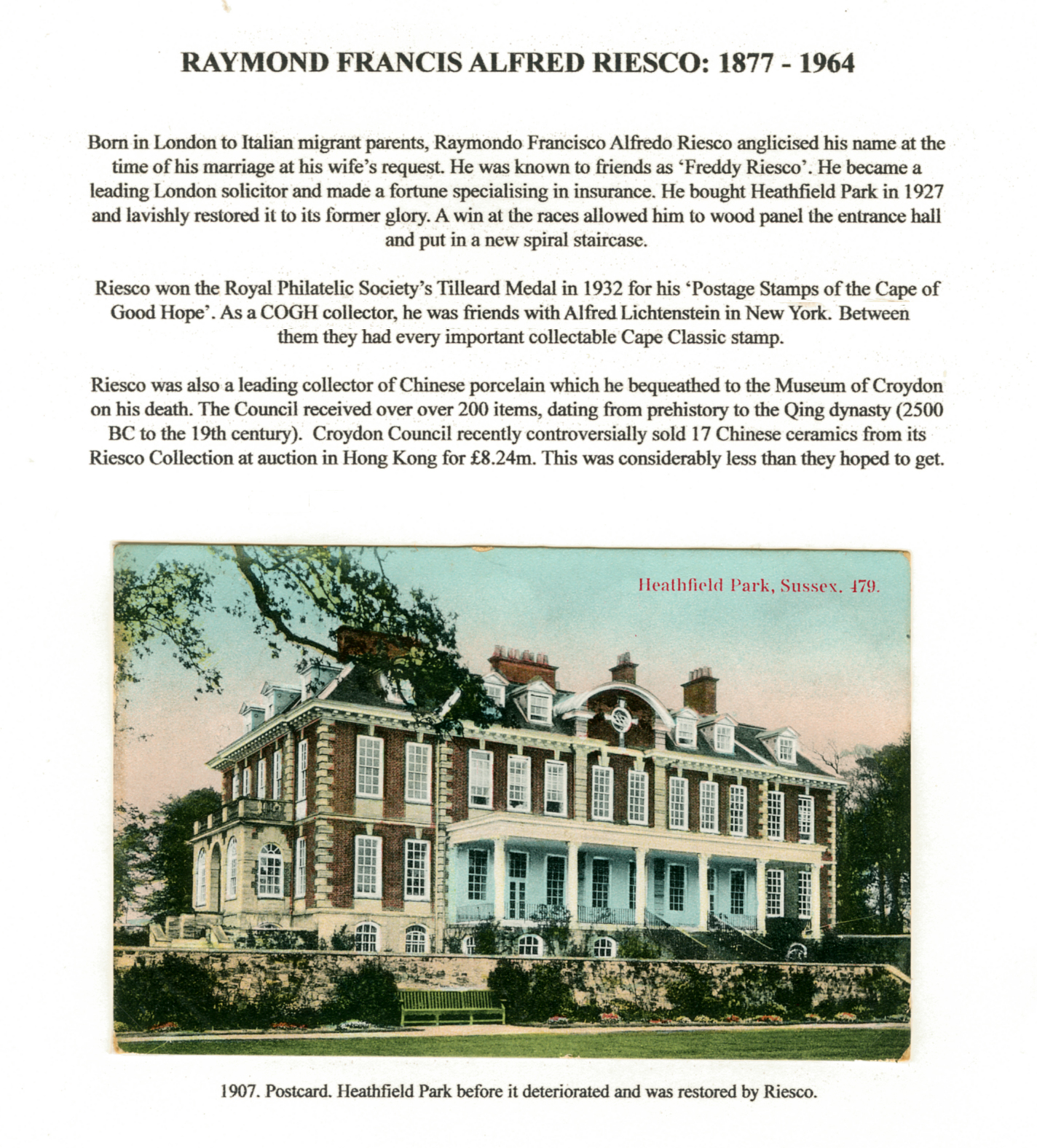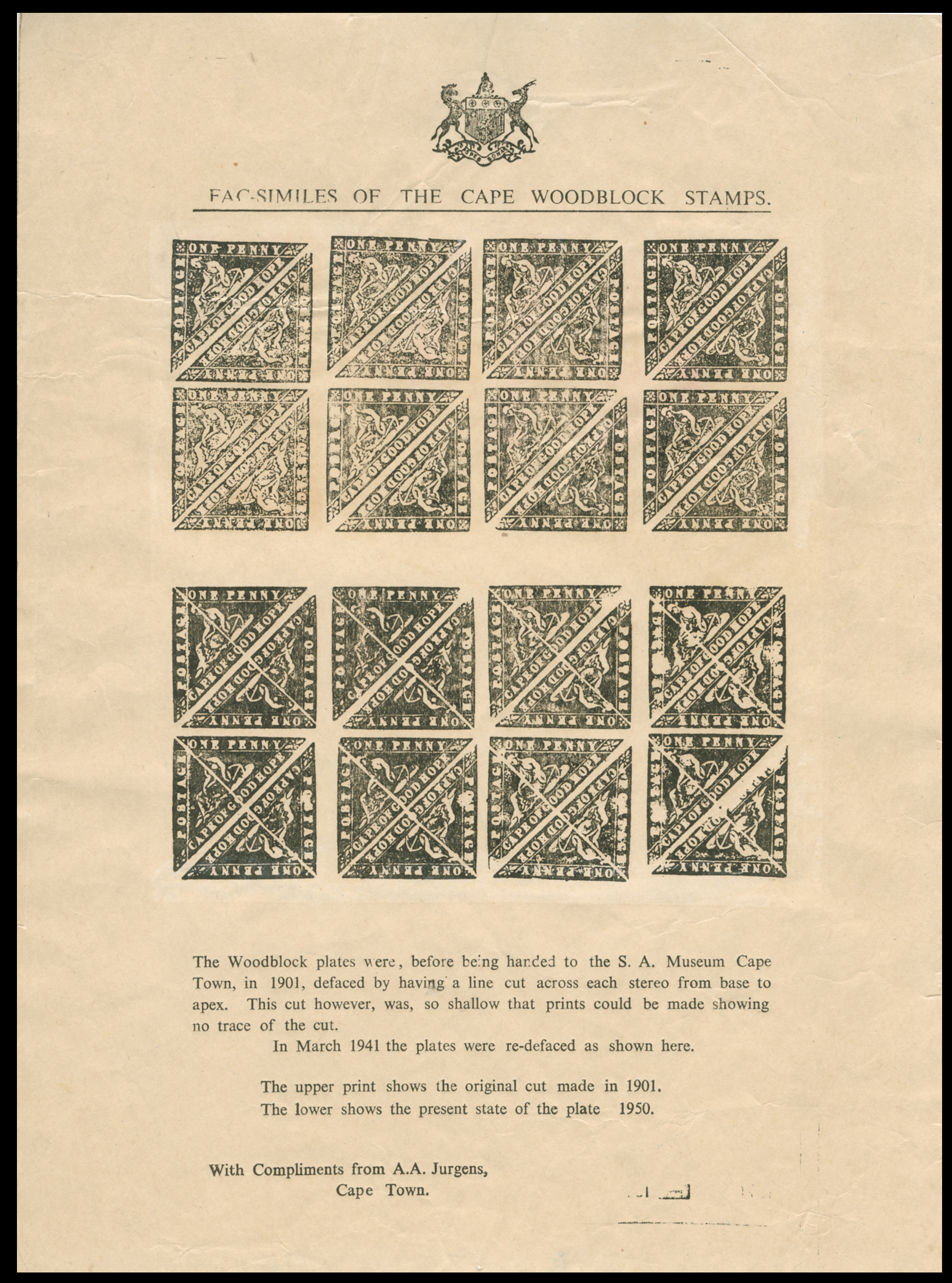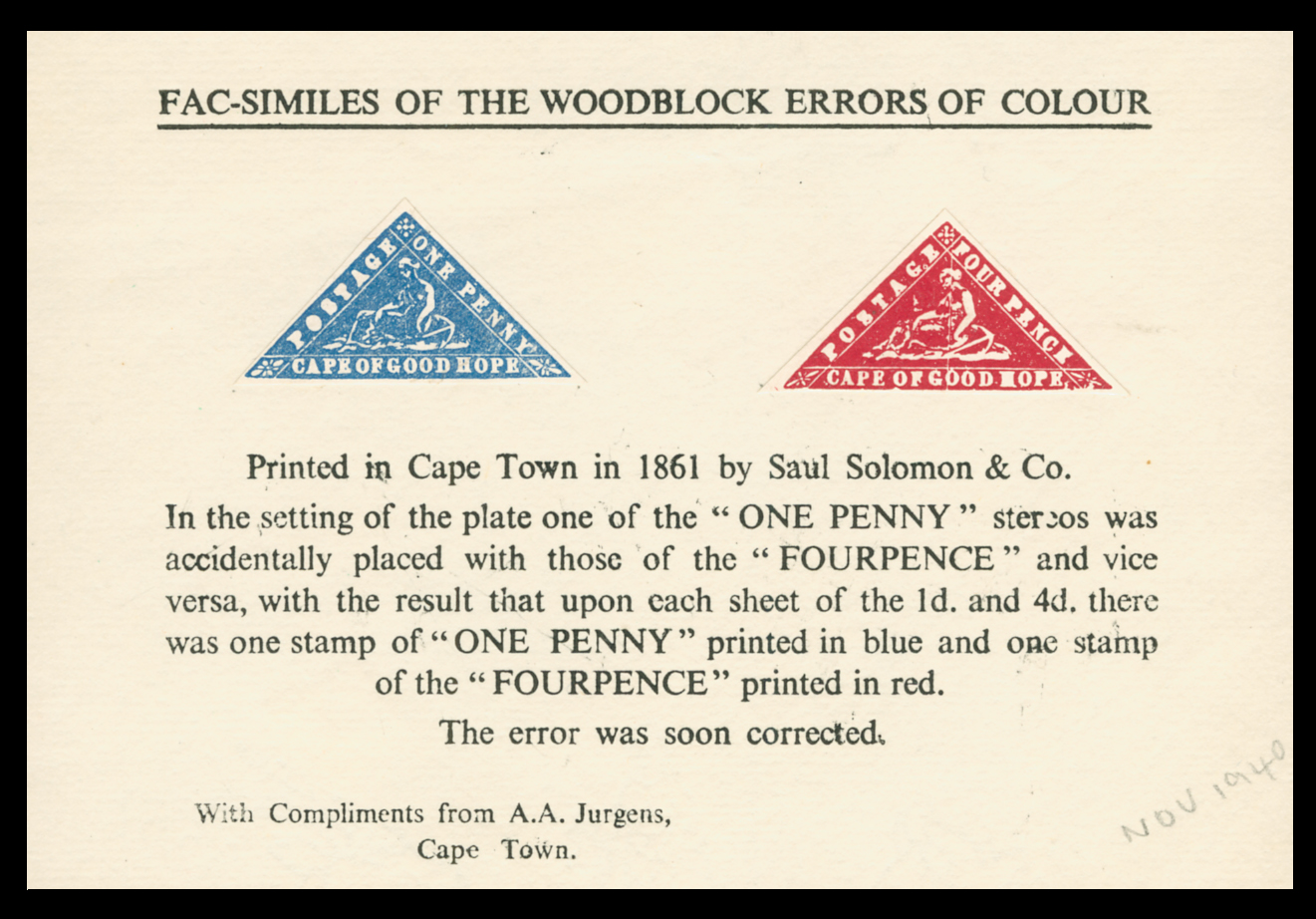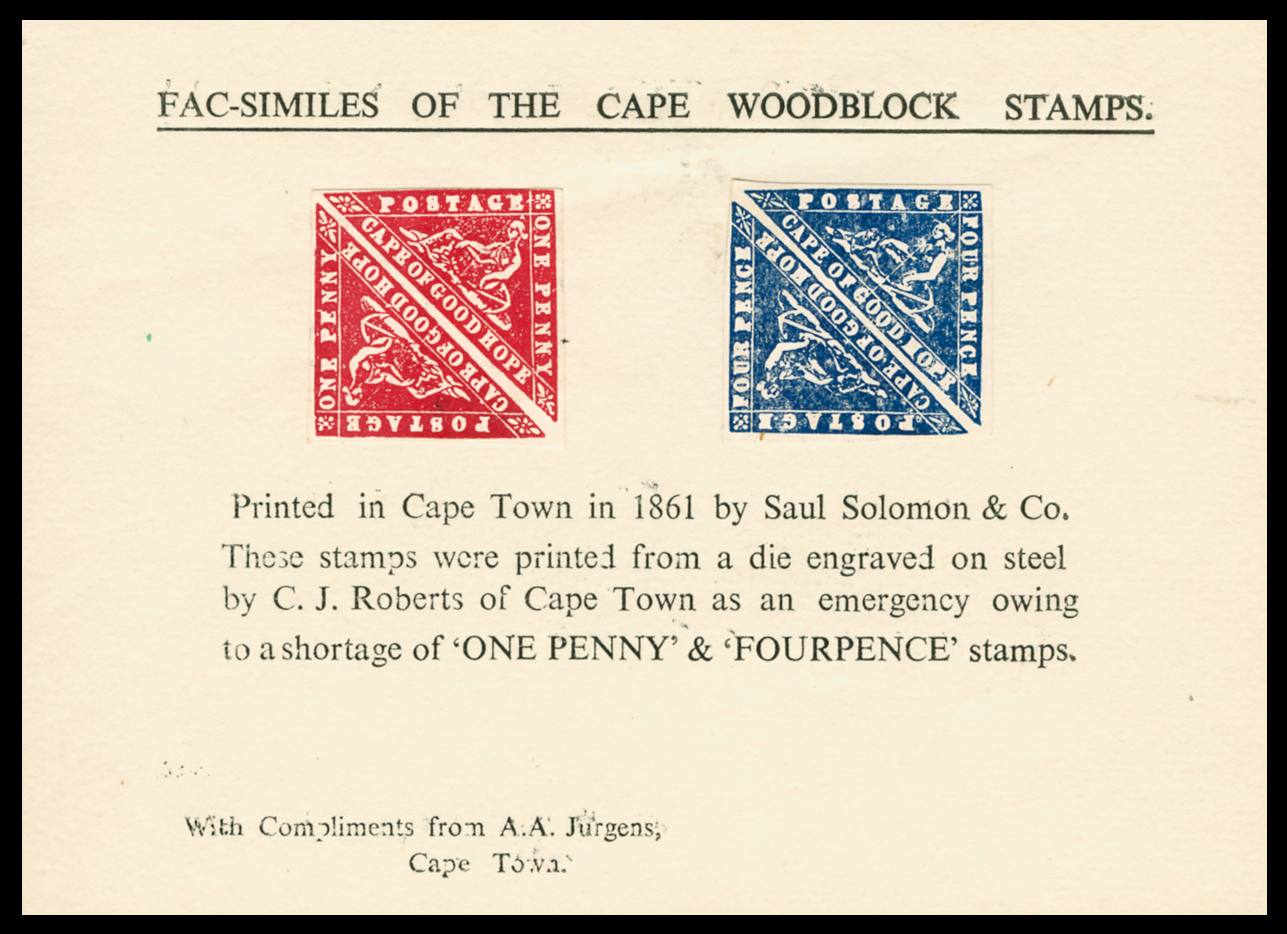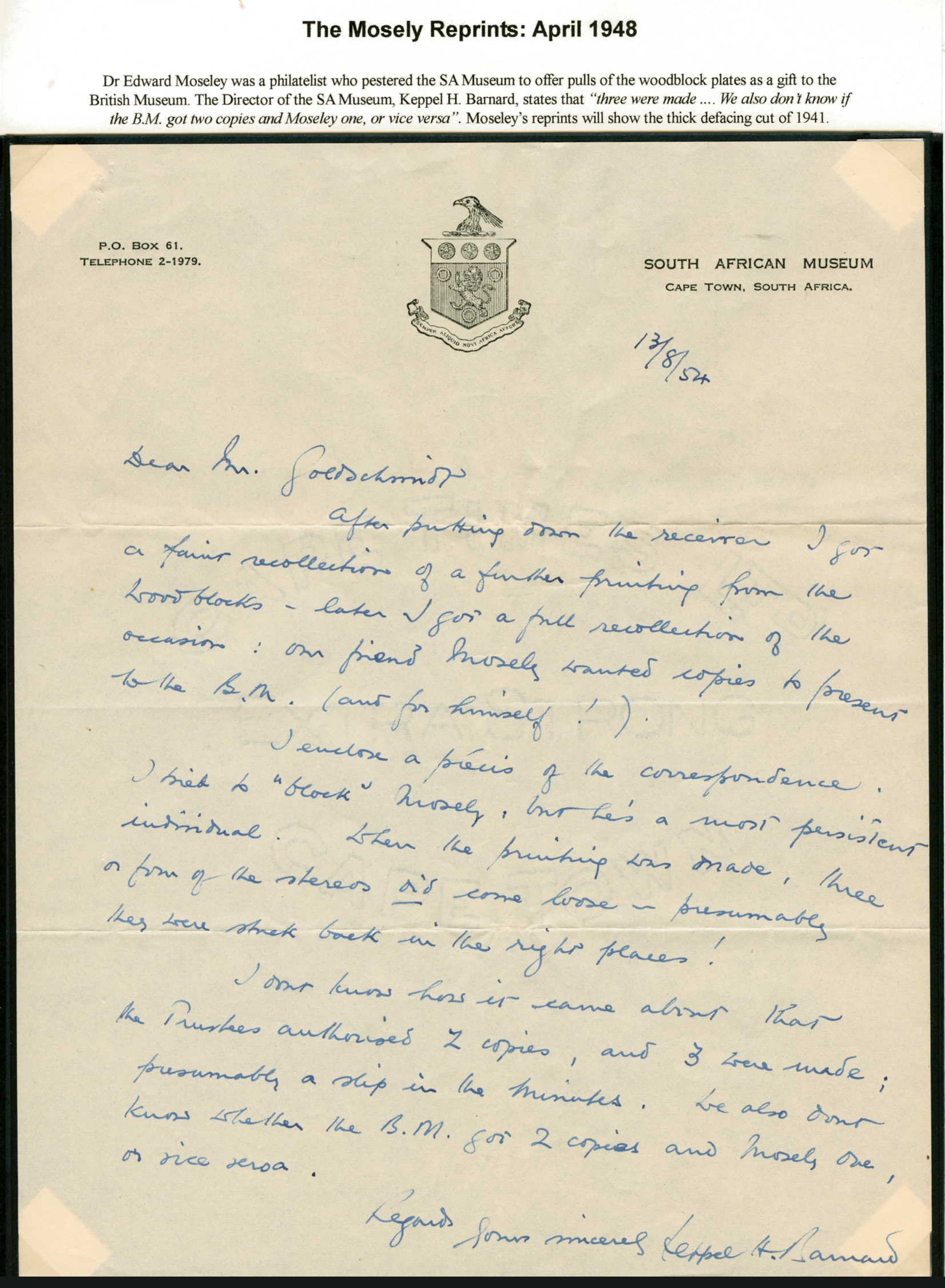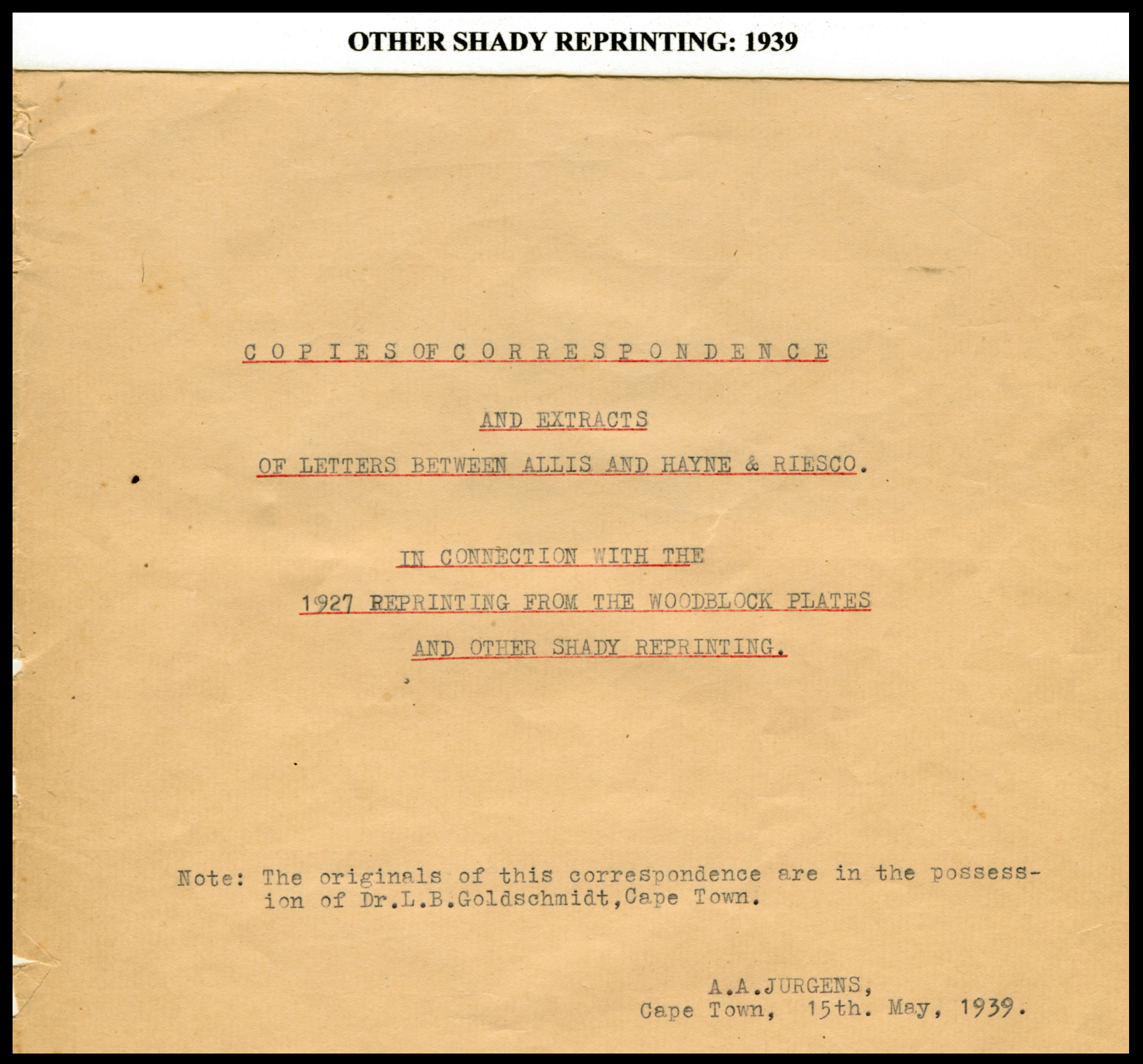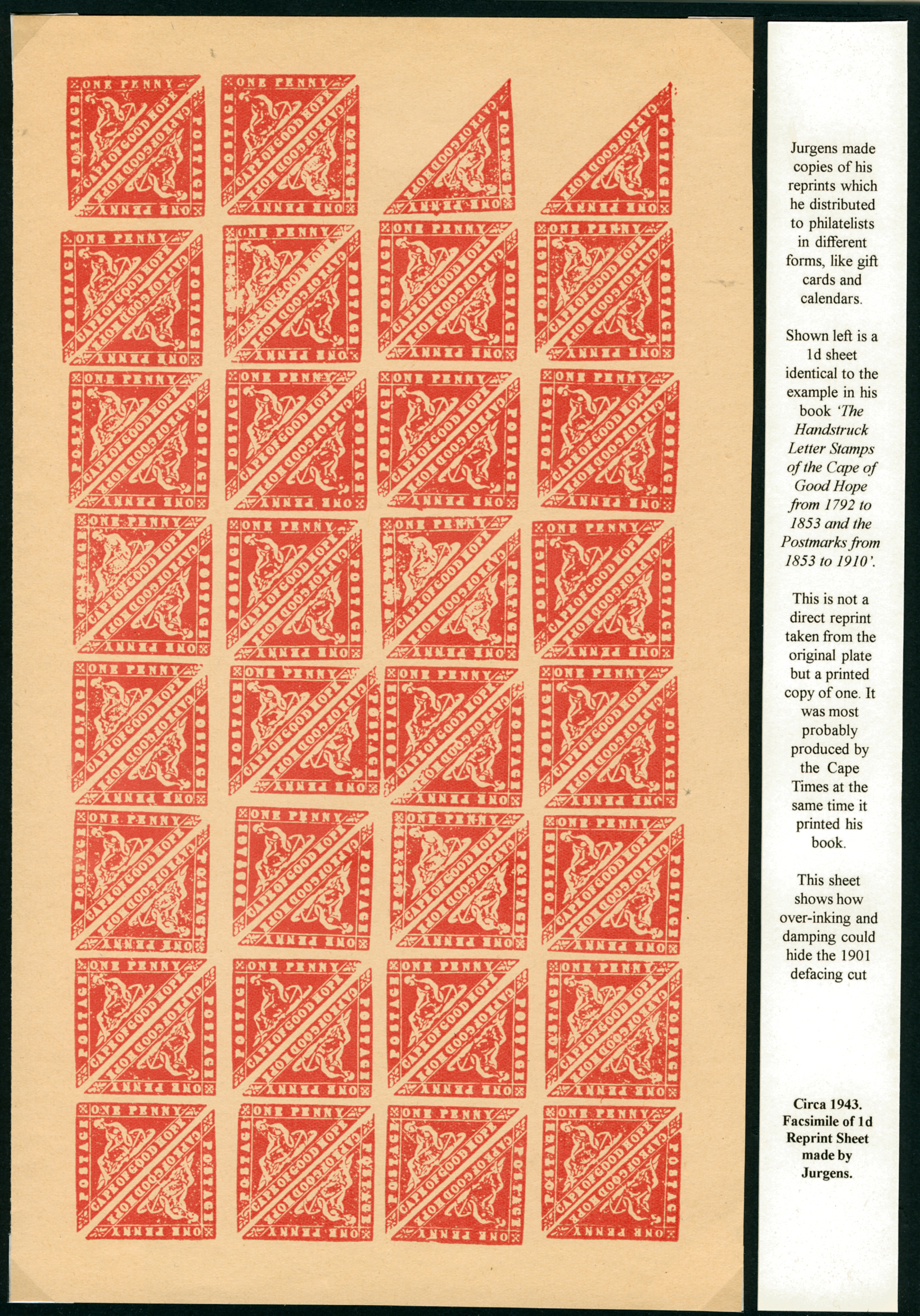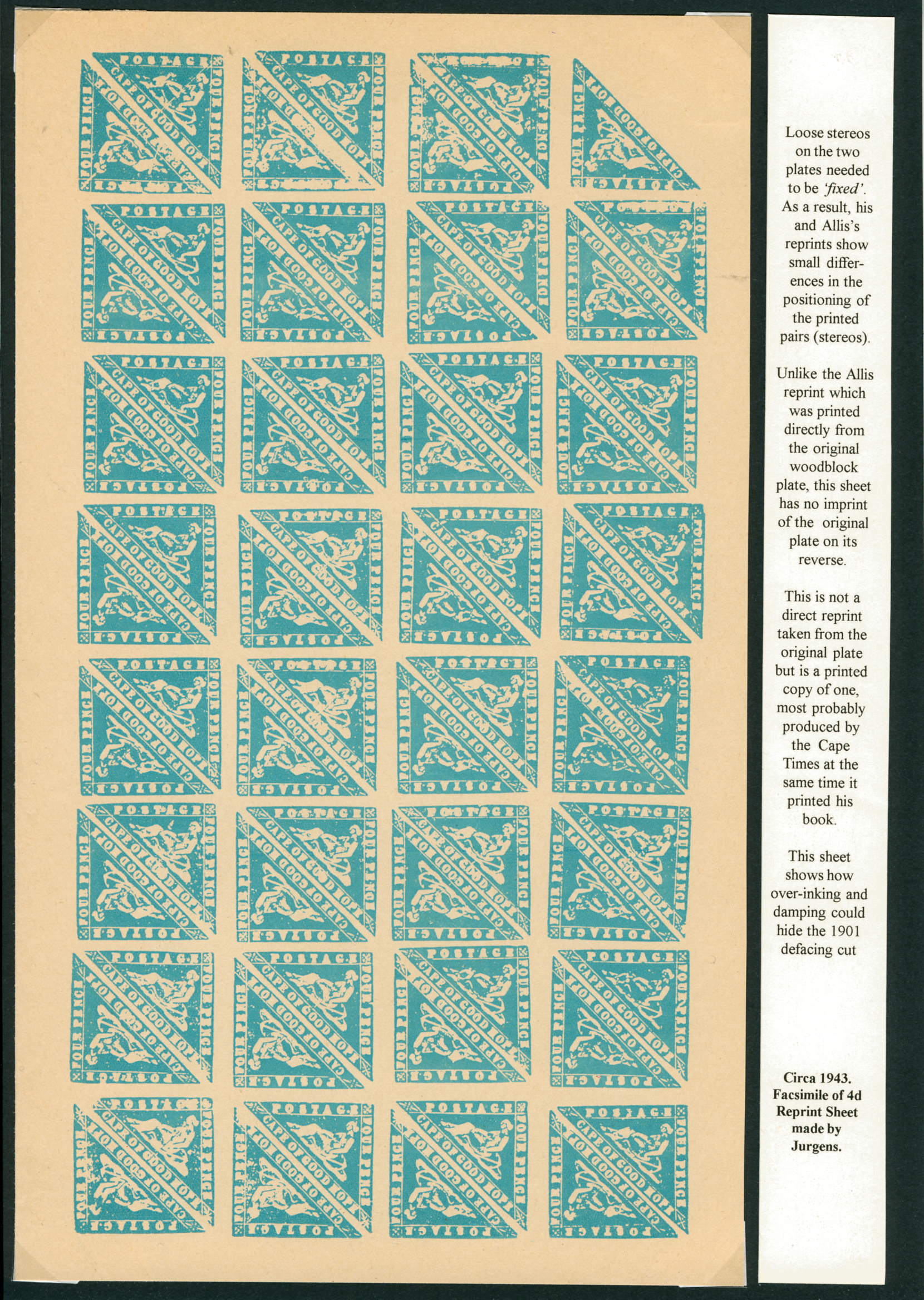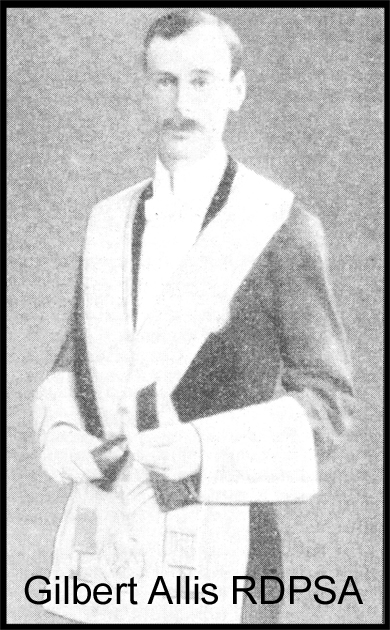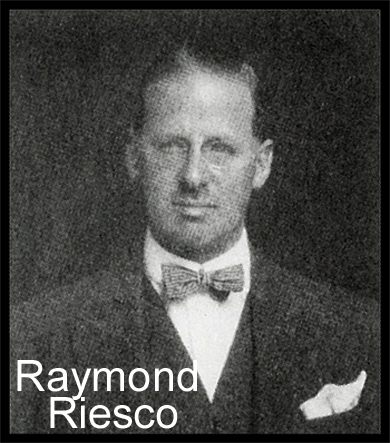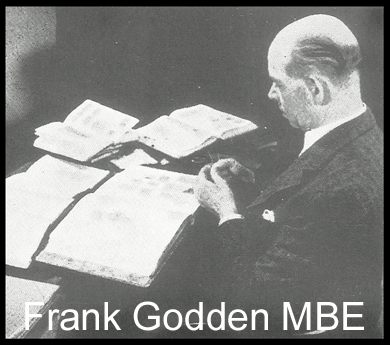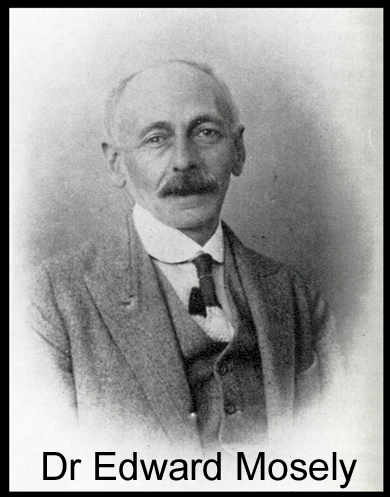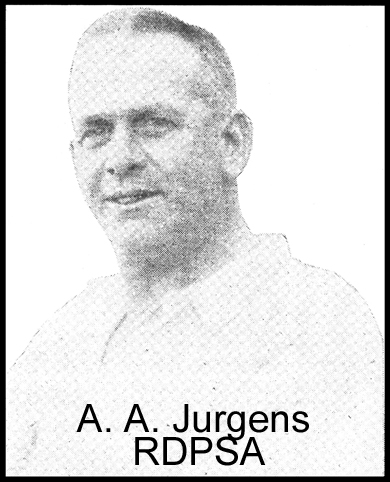Reprints of the Cape of Good Hope Woodblock
Quote from Steve on June 6, 2022, 11:31 am1883 - Reprints made by the Cape Post Office in order to supply samples to overseas Post Offices.
Five sets of authorised reprints have been made from Saul Solomon & Co.’s original Woodblock plates of 1861.
1883 - By the Cape Post Office in order to supply samples to overseas Post Offices.
1927 - By the SA Museum for Gilbert Allis RDPSA FRPSL in order to illustrate his book*.
1932 - By the SA Museum for Dr Edward Mosely.* Motive unknown.
1940 - 1941- By A A Jurgens RDPSA FRPSL on behalf of the SA Museum and not least himself.
1948 - By the SA Museum for Dr Edward Mosely as a gift to the British Museum and for himself.* Both the 1927 Allis and 1932 Mosely reprints were 'certificated' by the Director of the SA Museum.
I welcome all feedback on this subject. I started from a position of relative ignorance. Much of this is based on what I wrote up for a club competition. Your corrections, criticisms, input and examples are greatly welcomed
I shall add to this over the next few weeks. I start with the 1883 Reprint which was, according to the Cape Auditor General, a genuine postage stamp. Curiously, however, neither Stanley Gibbons nor the South African Colour Catalogue see fit to include them. IMO, this is an omission. Can someone confirm that Scott lists them in the USA, please? They are scarce as stamps and rare when postally used on cover.
1883 - Reprints made by the Cape Post Office in order to supply samples to overseas Post Offices.
Five sets of authorised reprints have been made from Saul Solomon & Co.’s original Woodblock plates of 1861.
1883 - By the Cape Post Office in order to supply samples to overseas Post Offices.
1927 - By the SA Museum for Gilbert Allis RDPSA FRPSL in order to illustrate his book*.
1932 - By the SA Museum for Dr Edward Mosely.* Motive unknown.
1940 - 1941- By A A Jurgens RDPSA FRPSL on behalf of the SA Museum and not least himself.
1948 - By the SA Museum for Dr Edward Mosely as a gift to the British Museum and for himself.
* Both the 1927 Allis and 1932 Mosely reprints were 'certificated' by the Director of the SA Museum.
I welcome all feedback on this subject. I started from a position of relative ignorance. Much of this is based on what I wrote up for a club competition. Your corrections, criticisms, input and examples are greatly welcomed
I shall add to this over the next few weeks. I start with the 1883 Reprint which was, according to the Cape Auditor General, a genuine postage stamp. Curiously, however, neither Stanley Gibbons nor the South African Colour Catalogue see fit to include them. IMO, this is an omission. Can someone confirm that Scott lists them in the USA, please? They are scarce as stamps and rare when postally used on cover.
Uploaded files:Quote from Steve on October 26, 2022, 9:14 am1901 - The 'Woodblock' Plates are defaced with a Fine Line Cut.
Cape of Good Hope triangular stamps were demonetised on 1st October 1900.
The SACC (South African Colour Catalogue) 2008/9 suggests that the reason for demonetising triangular adhesives was the fact that "some of these stamps" (the 1883 'Woodblock reprints) "came into the hands of the public and were used for postage". Such postal use is shown in the preceding cover used in Barkly West. However, SACC's use of "some" suggests that Cape postal use of the 1883 reprint was a trickle not a flood. It is rare!
The Cape of Good Hope triangle stands alongside the Penny Black as one of the most iconic stamps of all time. Desired by all collectors, only a minority could afford a real example. This created a market for cheap 'space-filler 'facsimiles to plug this and other gaps in their albums. In 1900 when Cape Triangles were demonetised it was the heyday of accomplished European philatelic forgers who made passable copies of rare stamps. None was easier to copy than the crude 'Woodblock'. While a loss of revenue by the postal use of the 1883 reprint was a legitimate cause for concern by the Cape Post Office, this was insignificant compared to the huge potential loss that popular COGH triangular "space fillers" could inflict were they to appear in large numbers in the Cape and be fraudulently used as postage.
The Cape Post Office’s solution was simple - demonetise all triangles. This also had the added benefit of finally getting rid of the need to cut triangles off any remaining sheets, one of the biggest and longest complaints that Cape postmaster's had about the nature of their work with the Cape Triangle, a stamp now well-past its sell-by date. Demonetisation solved both problems. It removed the threat of reprints and fakes and made only perforated stamps legal tender. The question now became one of "what to do with the 'Woodblock' plates?".
It was decided that given the Cape Triangular's importance within the development of a Cape and wider White South African historical narrative that the colonially-produced provisional 'Woodblock' plates be donated to the South African Mseum for display in Cape Town. Mindful of the Cape Post Office’s fiasco with the 'Woodblock' reprint of 1883, the plates were defaced with a fine line cut before they were handed over to the SA Museum in late 1901.
The 'Woodblock' stereos were defaced with a fine line cut across each triangular stamp from the apex to the base. This was thought to be enough to make any future printings from the plates show that they were obvious reprints. Unlike the 1883 official reprints, all later reprints would be made from defaced plates. Eric Rosenthal, the raconteur author of 'The Cape of Good Hope Triangular Stamp and its Story', (A. A. Balkema. 1957.), states that the plates were defaced "by the cutting of a hacksaw mark across the surface of each" stereo. This is unlikely as the original cut was thin and discreet, not rough, thick and crude as per a hacksaw. It is more likely that a sharp knife was used to score the surface of the 1901 plate. When A. A. Jurgens RDPSA FRPSL came to make his reprints in 1940, he found that if he dampened the paper and over-inked the plates the fine line disappeared. To ensure this could not happen again, Jurgens widened the defacing line, most probably using a hacksaw, after he had completed his reprints in 1941.
Below: Postcard showing SA Museum, Cape Town, circa 1910.
1901 - The 'Woodblock' Plates are defaced with a Fine Line Cut.
Cape of Good Hope triangular stamps were demonetised on 1st October 1900.
The SACC (South African Colour Catalogue) 2008/9 suggests that the reason for demonetising triangular adhesives was the fact that "some of these stamps" (the 1883 'Woodblock reprints) "came into the hands of the public and were used for postage". Such postal use is shown in the preceding cover used in Barkly West. However, SACC's use of "some" suggests that Cape postal use of the 1883 reprint was a trickle not a flood. It is rare!
The Cape of Good Hope triangle stands alongside the Penny Black as one of the most iconic stamps of all time. Desired by all collectors, only a minority could afford a real example. This created a market for cheap 'space-filler 'facsimiles to plug this and other gaps in their albums. In 1900 when Cape Triangles were demonetised it was the heyday of accomplished European philatelic forgers who made passable copies of rare stamps. None was easier to copy than the crude 'Woodblock'. While a loss of revenue by the postal use of the 1883 reprint was a legitimate cause for concern by the Cape Post Office, this was insignificant compared to the huge potential loss that popular COGH triangular "space fillers" could inflict were they to appear in large numbers in the Cape and be fraudulently used as postage.
The Cape Post Office’s solution was simple - demonetise all triangles. This also had the added benefit of finally getting rid of the need to cut triangles off any remaining sheets, one of the biggest and longest complaints that Cape postmaster's had about the nature of their work with the Cape Triangle, a stamp now well-past its sell-by date. Demonetisation solved both problems. It removed the threat of reprints and fakes and made only perforated stamps legal tender. The question now became one of "what to do with the 'Woodblock' plates?".
It was decided that given the Cape Triangular's importance within the development of a Cape and wider White South African historical narrative that the colonially-produced provisional 'Woodblock' plates be donated to the South African Mseum for display in Cape Town. Mindful of the Cape Post Office’s fiasco with the 'Woodblock' reprint of 1883, the plates were defaced with a fine line cut before they were handed over to the SA Museum in late 1901.
The 'Woodblock' stereos were defaced with a fine line cut across each triangular stamp from the apex to the base. This was thought to be enough to make any future printings from the plates show that they were obvious reprints. Unlike the 1883 official reprints, all later reprints would be made from defaced plates. Eric Rosenthal, the raconteur author of 'The Cape of Good Hope Triangular Stamp and its Story', (A. A. Balkema. 1957.), states that the plates were defaced "by the cutting of a hacksaw mark across the surface of each" stereo. This is unlikely as the original cut was thin and discreet, not rough, thick and crude as per a hacksaw. It is more likely that a sharp knife was used to score the surface of the 1901 plate. When A. A. Jurgens RDPSA FRPSL came to make his reprints in 1940, he found that if he dampened the paper and over-inked the plates the fine line disappeared. To ensure this could not happen again, Jurgens widened the defacing line, most probably using a hacksaw, after he had completed his reprints in 1941.
Below: Postcard showing SA Museum, Cape Town, circa 1910.
Uploaded files:Quote from Steve on October 26, 2022, 10:10 am1927 - Reprints made by the SA Museum for Gilbert Allis RDPSA FRPSL in order to illustrate his book.
The 1927 reprint was the first known to be made by the SA Museum, Cape Town. It was made under the strict supersvision of the SA Museum for Gilbert Allis RDPSA FRPSL in order to illustrate his reference book, the 'Cape of Good Hope. Its Postal History and Postage Stamps', published by Stanley Gibbons in London in 1930.
Using the defaced plates of 1901, Allis says "two prints in black.... were taken upon a small printing press on the premises, from each of the two Woodblock plates (1d. and 4d,) and two prints from the original dies from which the stereos on the woodblock plates were manufactured" ie. eight prints in to total. "Upon one each of the prints from the plates and upon one of the prints from the dies", ie. four in total, "a certificate was written".
The 'certificate' was written in manuscript on the reverse of the printed sheet as follows: "PRINTED at the South African Museum, Cape Town, on the 30th March 1927, from the plates ('s' CROSSED OUT) in the possession of the Museum, for the purpose of publication in the book "The Stamps of the Cape of Good Hope", by permission of the Director. Only two copies were printed, the other for exhibition in the Museum. The waste was destroyed."
(Signed)
James Drury Taxidermist.
J. le Roux, Printer.
A. Hayne, Numismatist.
E. Leonard Gill, Director.The certificate is accompanied on the reverse of the 4d sheet with the South African Museum Library datestamp of '30 MAR 1927' in purple ink. It appears to have been witten by A Neville Hayne, Museum Numismatist. It suggests that he managed the reprinting.
A subsequent report says the reprints with certificates behind them were “specifically for the purpose of Allis' handbook”. All the 1927 reprints were handed to Hayne who was supposed to give Allis the certificated ones. However, Hayne provided only the certificated reprint from the 1d plate, one reprint from the 4d plate without certificate and no copies of the die reprints. This caused a great problem for Allis who had promised if not sold the missing 4d reprint with certificate to Raymond Riesco, a leading CoGH collector. Through the intervention of Frank Godden MBE, Strand dealer, Riesco eventually acquired a 4d reprint with certificate.
Recently new information has come to light that Hayne, the Museum's Numismatist, was a 'dealer', in both coins and stamps. His self-interest in profiting from the 1927 triangular reprints possibly explains his behaviour toward Allis, specifically why he withheld some items. In attempting to retrieve the certificated 4d plate from Hayne, Allis resorted to offering him a special deals on stamps. Some of these offers are documented by Jurgens. . The cover below was written by Hayne and addressed to himself Poste Restante Cape Town using a return address of 'The Union Stamp Depot, PO Box 2165, Cape Town'. It suggests that Hayne traded in stamps and covers under that name using that PO Box address. (I have inserted Hayne' signature from the certificate so that readers can compare the handwriting).
It is also believed that Hayne sold the missing 4d reprint with certificate (below) to Dr L. B. Goldschmidt of Cape Town for £27.10/-. The other uncertificated 4d sheet presumably remained in the South African Museum in Cape Town. This brings into question exactly how many certificated reprints were made and when.
Allis, a British-born South African philatelist, was awarded a Gold Medal for his Cape of Good Hope display at the South African Philatelic Exhibition in Durban, 30th June - 5th July 1913. President of the Cape Town Philatelic Society and Exchange Club, (later the Royal Philatelic Society of Cape Town), he was awarded the Crawford Medal by the Royal Philatelic Society London in 1931 for his work 'Cape of Good Hope: Its Postal History and Postage Stamps'. In 1932 he became the first signatory to the Roll of Distinguished Philatelists of South Africa. He died soon after aged 53.
If, as Allis said, the only signed, certificated and datestamped 4d reprint example was intended for use in his book, a statement corroborated by the 'certificate, then it must follow that the example shown below can only be the one he should have received but which was witheld by Hayne who, according to Jurgens, later sold to Dr Goldschmidt.
See below:
1]. The 4d 'Allis' reprint of 1927 that was withheld by Hayne and sold to Dr Goldschmidt.
2]. The 'certificate' on the reverse.
3]. SA Museum Library datestamp accompanying the 'certificate'.
4].Part Jurgens' typed-up copy of Allis' report to Godden (Riesco's agent) on what happened.
5]. 1929 Poste restante cover in Hayne's handwriting with a return address of the 'Union Stamp Depot, Cape Town'.
1927 - Reprints made by the SA Museum for Gilbert Allis RDPSA FRPSL in order to illustrate his book.
The 1927 reprint was the first known to be made by the SA Museum, Cape Town. It was made under the strict supersvision of the SA Museum for Gilbert Allis RDPSA FRPSL in order to illustrate his reference book, the 'Cape of Good Hope. Its Postal History and Postage Stamps', published by Stanley Gibbons in London in 1930.
Using the defaced plates of 1901, Allis says "two prints in black.... were taken upon a small printing press on the premises, from each of the two Woodblock plates (1d. and 4d,) and two prints from the original dies from which the stereos on the woodblock plates were manufactured" ie. eight prints in to total. "Upon one each of the prints from the plates and upon one of the prints from the dies", ie. four in total, "a certificate was written".
The 'certificate' was written in manuscript on the reverse of the printed sheet as follows: "PRINTED at the South African Museum, Cape Town, on the 30th March 1927, from the plates ('s' CROSSED OUT) in the possession of the Museum, for the purpose of publication in the book "The Stamps of the Cape of Good Hope", by permission of the Director. Only two copies were printed, the other for exhibition in the Museum. The waste was destroyed."
(Signed)
James Drury Taxidermist.
J. le Roux, Printer.
A. Hayne, Numismatist.
E. Leonard Gill, Director.
The certificate is accompanied on the reverse of the 4d sheet with the South African Museum Library datestamp of '30 MAR 1927' in purple ink. It appears to have been witten by A Neville Hayne, Museum Numismatist. It suggests that he managed the reprinting.
A subsequent report says the reprints with certificates behind them were “specifically for the purpose of Allis' handbook”. All the 1927 reprints were handed to Hayne who was supposed to give Allis the certificated ones. However, Hayne provided only the certificated reprint from the 1d plate, one reprint from the 4d plate without certificate and no copies of the die reprints. This caused a great problem for Allis who had promised if not sold the missing 4d reprint with certificate to Raymond Riesco, a leading CoGH collector. Through the intervention of Frank Godden MBE, Strand dealer, Riesco eventually acquired a 4d reprint with certificate.
Recently new information has come to light that Hayne, the Museum's Numismatist, was a 'dealer', in both coins and stamps. His self-interest in profiting from the 1927 triangular reprints possibly explains his behaviour toward Allis, specifically why he withheld some items. In attempting to retrieve the certificated 4d plate from Hayne, Allis resorted to offering him a special deals on stamps. Some of these offers are documented by Jurgens. . The cover below was written by Hayne and addressed to himself Poste Restante Cape Town using a return address of 'The Union Stamp Depot, PO Box 2165, Cape Town'. It suggests that Hayne traded in stamps and covers under that name using that PO Box address. (I have inserted Hayne' signature from the certificate so that readers can compare the handwriting).
It is also believed that Hayne sold the missing 4d reprint with certificate (below) to Dr L. B. Goldschmidt of Cape Town for £27.10/-. The other uncertificated 4d sheet presumably remained in the South African Museum in Cape Town. This brings into question exactly how many certificated reprints were made and when.
Allis, a British-born South African philatelist, was awarded a Gold Medal for his Cape of Good Hope display at the South African Philatelic Exhibition in Durban, 30th June - 5th July 1913. President of the Cape Town Philatelic Society and Exchange Club, (later the Royal Philatelic Society of Cape Town), he was awarded the Crawford Medal by the Royal Philatelic Society London in 1931 for his work 'Cape of Good Hope: Its Postal History and Postage Stamps'. In 1932 he became the first signatory to the Roll of Distinguished Philatelists of South Africa. He died soon after aged 53.
If, as Allis said, the only signed, certificated and datestamped 4d reprint example was intended for use in his book, a statement corroborated by the 'certificate, then it must follow that the example shown below can only be the one he should have received but which was witheld by Hayne who, according to Jurgens, later sold to Dr Goldschmidt.
See below:
1]. The 4d 'Allis' reprint of 1927 that was withheld by Hayne and sold to Dr Goldschmidt.
2]. The 'certificate' on the reverse.
3]. SA Museum Library datestamp accompanying the 'certificate'.
4].Part Jurgens' typed-up copy of Allis' report to Godden (Riesco's agent) on what happened.
5]. 1929 Poste restante cover in Hayne's handwriting with a return address of the 'Union Stamp Depot, Cape Town'.
Uploaded files:
Quote from Steve on October 26, 2022, 11:14 am1932 - Reprints made by the SA Museum (apparently for Dr Edward Mosely. Motive unknown).
This is the least documented reprinting of the 'Woodblock' plates. It is probably wrong to associate this reprinting with Dr Edward Mosely directly. It is likely that this 1932 reprinting was made to sort out the mess that Hayne had got Allis into. It is possible that as a very senior and persuasive South African collector Dr Mosely simply applied some pressure to acquire examples of the 1932 reprint which subsequently made their way into his collection.
Given that only five years had passed since Dr Gill exercised what Allis said was "strict control"' over the 1927 reprinting for his reference book, it is likely that Dr Gill, (SA Museum Curator 1925 - 1946), would have insisted that this also be made under strict control in black, not colour. Because the reprint was made from the fine line cut plate, it would have looked very much like the Allis reprint. Importantly, we know that it was also 'certificated'.
James Mackay, in describing "The Mosely Collection", (page 59, Philately Sept/October 1964) says that it includes "Pulls from the original Woodblock dies signed (certificated) by E.G Gill, Director of the South African Museum, in 1932, (with very faint lines defacing the steros) are matched by similar pulls taken with the lines deepened." This deeper cut is the result of Jurgens' handiwork with a hacksaw in 1941 and refers to the reprint made by the SA Museum for a persistent Dr Mosely in 1948. (See SA Museum Director Keppel Barnard's letter of 1954 to Dr Goldschmidt.)
Disovering the basic details of the certificated reprint of 1932 was a breakthrough. In discovering that Dr Mosely had acquired a certificated fine line cut reprint in 1932, we can understand his persistence in trying to get a sample of the thick line cut Jurgens made in 1941. He was simply trying to provide the British Museum's philatelic archive with examples of both reprints. His 'Mosely Collection of British Africa' stamps dating to 1935 was donated to the British Museum in 1946 and is now held as part of the British Library Philatelic Collections. After the Tapling Collection, it is considered the Library's most important philatelic acquisition. (Wikipedia 2022.)
The discovery of a 1932 'pull' explains how Allis was dug out of his can of worms. When he arrived in London in 1927 he hoped Stanley Gibbons would publish his book. They liked what they saw but felt it needed to be improved by the addition of some top quality items. Stanley Gibbons referred him to the acclaimed Cape collector Raymond Riesco. To cut a long story short, Riesco loaned Allis money which her could not pay back in full. As a result Allis promised Riesco the certificated reprints that he had, including the 4d certicated reprint which Hayne had withheld. He presumably hoped to get it from Hayne who by this time may have already sold it to Dr Goldschmidt.
Riesco is vague about dates. He recalls Allis turning up in his London office "in late 1931". Allis announces to Riesco "that he had now succeeded in obtaining the 2nd original pull from the 4d Woodblock plate fully authenticated and signed by the Museum Authorities" But how could he if this had been sold to Dr Goldschmidt? The bottom line is that Riesco, a hugely successful London solicitor and leading Cape collector (among other things), is angry. His problem with Allis and Allis' problem with Hayne has come to the boil and he is threatening an embarrassing exposé. The fuss that was being created by Riesco, his agent Godden and Allis as a result of Hayne witholding and selling the 4d certificated sheet to Dr Goldschmidt was not the sort of publicity that Dr Gill and the SA Museum wanted.
I suspect that the primary motivation for the 1932 reprint was to avoid international philatelic embarrassment to the SA Museum. Riesco had warned Allis that being a good friend of Alfred Lichtenstein in New York, the other great Cape collector, he could ruin Allis' already tarnished reputation, as well as that of the SA Museum. If and when Dr Gill heard of this threat, he presumably decided that the SA Museum would make another set of reprints subject to the same conditions but under his control, not Hayne's. I assume because I do not know that the 1932 reprint provided Riesco with what he wanted. It kept the lid on the can of worms and the SA Museum out of the international philatelic press. It also gave Dr Mosley what he wanted, reprints showing the fine line cut of 1901. If correct, this may explain the small variations in Jurgens' description of the certificate. He was looking at a 1932 certificate, not a 1927 one.
Below: Postcard showing Riescos' house, Heathfield Park, (circa 1905) before he purchased it.
1932 - Reprints made by the SA Museum (apparently for Dr Edward Mosely. Motive unknown).
This is the least documented reprinting of the 'Woodblock' plates. It is probably wrong to associate this reprinting with Dr Edward Mosely directly. It is likely that this 1932 reprinting was made to sort out the mess that Hayne had got Allis into. It is possible that as a very senior and persuasive South African collector Dr Mosely simply applied some pressure to acquire examples of the 1932 reprint which subsequently made their way into his collection.
Given that only five years had passed since Dr Gill exercised what Allis said was "strict control"' over the 1927 reprinting for his reference book, it is likely that Dr Gill, (SA Museum Curator 1925 - 1946), would have insisted that this also be made under strict control in black, not colour. Because the reprint was made from the fine line cut plate, it would have looked very much like the Allis reprint. Importantly, we know that it was also 'certificated'.
James Mackay, in describing "The Mosely Collection", (page 59, Philately Sept/October 1964) says that it includes "Pulls from the original Woodblock dies signed (certificated) by E.G Gill, Director of the South African Museum, in 1932, (with very faint lines defacing the steros) are matched by similar pulls taken with the lines deepened." This deeper cut is the result of Jurgens' handiwork with a hacksaw in 1941 and refers to the reprint made by the SA Museum for a persistent Dr Mosely in 1948. (See SA Museum Director Keppel Barnard's letter of 1954 to Dr Goldschmidt.)
Disovering the basic details of the certificated reprint of 1932 was a breakthrough. In discovering that Dr Mosely had acquired a certificated fine line cut reprint in 1932, we can understand his persistence in trying to get a sample of the thick line cut Jurgens made in 1941. He was simply trying to provide the British Museum's philatelic archive with examples of both reprints. His 'Mosely Collection of British Africa' stamps dating to 1935 was donated to the British Museum in 1946 and is now held as part of the British Library Philatelic Collections. After the Tapling Collection, it is considered the Library's most important philatelic acquisition. (Wikipedia 2022.)
The discovery of a 1932 'pull' explains how Allis was dug out of his can of worms. When he arrived in London in 1927 he hoped Stanley Gibbons would publish his book. They liked what they saw but felt it needed to be improved by the addition of some top quality items. Stanley Gibbons referred him to the acclaimed Cape collector Raymond Riesco. To cut a long story short, Riesco loaned Allis money which her could not pay back in full. As a result Allis promised Riesco the certificated reprints that he had, including the 4d certicated reprint which Hayne had withheld. He presumably hoped to get it from Hayne who by this time may have already sold it to Dr Goldschmidt.
Riesco is vague about dates. He recalls Allis turning up in his London office "in late 1931". Allis announces to Riesco "that he had now succeeded in obtaining the 2nd original pull from the 4d Woodblock plate fully authenticated and signed by the Museum Authorities" But how could he if this had been sold to Dr Goldschmidt? The bottom line is that Riesco, a hugely successful London solicitor and leading Cape collector (among other things), is angry. His problem with Allis and Allis' problem with Hayne has come to the boil and he is threatening an embarrassing exposé. The fuss that was being created by Riesco, his agent Godden and Allis as a result of Hayne witholding and selling the 4d certificated sheet to Dr Goldschmidt was not the sort of publicity that Dr Gill and the SA Museum wanted.
I suspect that the primary motivation for the 1932 reprint was to avoid international philatelic embarrassment to the SA Museum. Riesco had warned Allis that being a good friend of Alfred Lichtenstein in New York, the other great Cape collector, he could ruin Allis' already tarnished reputation, as well as that of the SA Museum. If and when Dr Gill heard of this threat, he presumably decided that the SA Museum would make another set of reprints subject to the same conditions but under his control, not Hayne's. I assume because I do not know that the 1932 reprint provided Riesco with what he wanted. It kept the lid on the can of worms and the SA Museum out of the international philatelic press. It also gave Dr Mosley what he wanted, reprints showing the fine line cut of 1901. If correct, this may explain the small variations in Jurgens' description of the certificate. He was looking at a 1932 certificate, not a 1927 one.
Below: Postcard showing Riescos' house, Heathfield Park, (circa 1905) before he purchased it.
Uploaded files:Quote from Steve on October 26, 2022, 12:24 pm1940 - 1941 - Reprints made by A. A. Jurgens RDPSA FRPSL on behalf of himself.
Adrian Albert Jurgens is the source of most of the defaced 'Woodblock' reprints, both official and unofficial.
Jurgens became a signatory to the RDPSA (Roll of Distinguished Philatelists of Southern Africa) in 1948 and the Roll of Distinguished Philatelists in Great Britain in 1952. In 1944 he won the Crawford Medal from the Royal Philatelic Society London for his 'The Handstruck Letter Stamps of the Cape of Good Hope from 1792 to 1853 and the Postmarks from 1853 to 1910'. Did Jurgens harbour a sense of rivalry between him and Allis who was the first South African philatelist to sign the Roll and win the Crawford Medal?
They were known to each other as members of the same Cape Town philatelic society. Like Allis', Jurgens' book contained reproductions of the 1d red and 4d blue 'Woodblock' sheets. This was in imitation of what Allis had done. Given what Jurgens subsequently wrote about Allis one must suspect that Jurgens viewed Allis as an inferior rival whose career and success had constantly pipped him to the limelighted post. At some point after Allis' success, Jurgens was driven to bring his reputation into disrepute. I have undated notes by Jurgens headed "So said Allis" in which he highlights Allis' problems with Riesco. They are, in my opinion, nothing less than an attempt to smear Allis' name. However, in Jurgens' defence, without his "So said Allis" notes I would not be able to have written this post.
In 1941 Jurgens became embroiled in allegations of forgery that never went away and which greatly damaged his reputation. Given the cloak of subterfuge that he wore, it is difficult to determine with accuracy exactly what he produced when he worked alone with the 'Woodblock' plates. While I am uncertain of the date when Jurgens compiled the "So said Allis" notes, it is undoubtedly the pot calling the kettle black, and secondly, it is quite possibly also a deliberate attempt to deflect attention away from his activities and onto Allis.
In 1941 philatelists became aware of reprints of the 1d red and 4d Cape of Good Hope 'Woodblock' stamps in the original colours. Although the original stereos had been defaced with a vertical line, the line did not appear correctly on the reprints which were dangerously similar to the originals. The originator of the reprints was revealed to be A.A. Jurgens who described everything he had done in an article in The South African Philatelist in May 1941. Jurgens explained that he had received permission to make reprints in black from the Director of the South African Museum in Cape Town which were to be displayed in a case with South African postal history material.
Unfortunately, Jurgens appears to have got carried away with his initial success and he also produced reprints in red and blue and on wove and laid papers. Apparently, up to 17 sheets were produced. This was done between November 1940 and March 1941 without the knowledge of the philatelic community. Further allegations relating to forged cancellations on Cape material and a public spat with the expert committee of the British Philatelic Association did nothing to help Jurgens' reputation. Robson Lowe, one of the founding fathers of postal history, famously declined to sign the Roll of Distinguished Philatelists (of Great Britain) due to the organisers' failure to delete Jurgens' name from the Roll. Lowe regarded Jurgens as a forger and dared to say so. Neither Britain nor South Africa deleted his name.
Below:
1]. Jurgens comparison sheet showing facsimile fine line cut (1901 - 1941) and thick line cut of 1941.
2]. Jurgens presentation sheet showing single heavily-inked 'error of colour' woodblock reprints.
3]. Jurgens presentation sheet showing pairs of 1d red and 4d blue woodbock reprints.
1940 - 1941 - Reprints made by A. A. Jurgens RDPSA FRPSL on behalf of himself.
Adrian Albert Jurgens is the source of most of the defaced 'Woodblock' reprints, both official and unofficial.
Jurgens became a signatory to the RDPSA (Roll of Distinguished Philatelists of Southern Africa) in 1948 and the Roll of Distinguished Philatelists in Great Britain in 1952. In 1944 he won the Crawford Medal from the Royal Philatelic Society London for his 'The Handstruck Letter Stamps of the Cape of Good Hope from 1792 to 1853 and the Postmarks from 1853 to 1910'. Did Jurgens harbour a sense of rivalry between him and Allis who was the first South African philatelist to sign the Roll and win the Crawford Medal?
They were known to each other as members of the same Cape Town philatelic society. Like Allis', Jurgens' book contained reproductions of the 1d red and 4d blue 'Woodblock' sheets. This was in imitation of what Allis had done. Given what Jurgens subsequently wrote about Allis one must suspect that Jurgens viewed Allis as an inferior rival whose career and success had constantly pipped him to the limelighted post. At some point after Allis' success, Jurgens was driven to bring his reputation into disrepute. I have undated notes by Jurgens headed "So said Allis" in which he highlights Allis' problems with Riesco. They are, in my opinion, nothing less than an attempt to smear Allis' name. However, in Jurgens' defence, without his "So said Allis" notes I would not be able to have written this post.
In 1941 Jurgens became embroiled in allegations of forgery that never went away and which greatly damaged his reputation. Given the cloak of subterfuge that he wore, it is difficult to determine with accuracy exactly what he produced when he worked alone with the 'Woodblock' plates. While I am uncertain of the date when Jurgens compiled the "So said Allis" notes, it is undoubtedly the pot calling the kettle black, and secondly, it is quite possibly also a deliberate attempt to deflect attention away from his activities and onto Allis.
In 1941 philatelists became aware of reprints of the 1d red and 4d Cape of Good Hope 'Woodblock' stamps in the original colours. Although the original stereos had been defaced with a vertical line, the line did not appear correctly on the reprints which were dangerously similar to the originals. The originator of the reprints was revealed to be A.A. Jurgens who described everything he had done in an article in The South African Philatelist in May 1941. Jurgens explained that he had received permission to make reprints in black from the Director of the South African Museum in Cape Town which were to be displayed in a case with South African postal history material.
Unfortunately, Jurgens appears to have got carried away with his initial success and he also produced reprints in red and blue and on wove and laid papers. Apparently, up to 17 sheets were produced. This was done between November 1940 and March 1941 without the knowledge of the philatelic community. Further allegations relating to forged cancellations on Cape material and a public spat with the expert committee of the British Philatelic Association did nothing to help Jurgens' reputation. Robson Lowe, one of the founding fathers of postal history, famously declined to sign the Roll of Distinguished Philatelists (of Great Britain) due to the organisers' failure to delete Jurgens' name from the Roll. Lowe regarded Jurgens as a forger and dared to say so. Neither Britain nor South Africa deleted his name.
Below:
1]. Jurgens comparison sheet showing facsimile fine line cut (1901 - 1941) and thick line cut of 1941.
2]. Jurgens presentation sheet showing single heavily-inked 'error of colour' woodblock reprints.
3]. Jurgens presentation sheet showing pairs of 1d red and 4d blue woodbock reprints.
Uploaded files:
Quote from Steve on October 26, 2022, 6:16 pmMany thanks Yannis.This is really just the basic background about the various reprints.
The actual story about the characters involved reads like a who-dunnit mystery. I will endeavour to finish this ASAP. I have written a very long article about this based on my own research and also using some correspondence which I bought that detailed the various printings. Many were notes written up by Jurgens in 1939 before he embarked on his own 'Woodblock' adventure at the SA Museum. Sadly I do not have all his notes. Jurgens adopted a holier-than-thou stance with regards to Allis. It stuck me that he was trying to get even with Allis, even destroy his reputation. Jurgen's notes are entitled "Correspondence and Extracts of Letters between Allis and Hayne and Riesco in Connection with the 1927 Reprinting from the Woodblock Plates AND OTHER SHADY REPRINTING".
Jurgens concludes "So said Allis". I won't go into Allis' private life but his problem was that he was neither a wealthy nor a healthy man. He relied on the generosity of others, got into debt with Riesco who assisted him with top quality Cape material for his book at Stanley Gibbons' request and made promises he could not keep. He was badly let down by A Hayne at the SA Museum who withheld the promised material from him. It turns out that Hayne was also a 'dealer". Hayne saw an opportunity to profit from the reprints. It is widely believed that he sold the certificated 4d sheet earmarked for Allis to Dr Goldschmidt in Cape Town. (Dr Goldschmidt wrote the forward to Jurgens' book!). Still,I get the strong feeling that Allis could have conducted himself better. He was not blameless.
Many thanks Yannis.This is really just the basic background about the various reprints.
The actual story about the characters involved reads like a who-dunnit mystery. I will endeavour to finish this ASAP. I have written a very long article about this based on my own research and also using some correspondence which I bought that detailed the various printings. Many were notes written up by Jurgens in 1939 before he embarked on his own 'Woodblock' adventure at the SA Museum. Sadly I do not have all his notes. Jurgens adopted a holier-than-thou stance with regards to Allis. It stuck me that he was trying to get even with Allis, even destroy his reputation. Jurgen's notes are entitled "Correspondence and Extracts of Letters between Allis and Hayne and Riesco in Connection with the 1927 Reprinting from the Woodblock Plates AND OTHER SHADY REPRINTING".
Jurgens concludes "So said Allis". I won't go into Allis' private life but his problem was that he was neither a wealthy nor a healthy man. He relied on the generosity of others, got into debt with Riesco who assisted him with top quality Cape material for his book at Stanley Gibbons' request and made promises he could not keep. He was badly let down by A Hayne at the SA Museum who withheld the promised material from him. It turns out that Hayne was also a 'dealer". Hayne saw an opportunity to profit from the reprints. It is widely believed that he sold the certificated 4d sheet earmarked for Allis to Dr Goldschmidt in Cape Town. (Dr Goldschmidt wrote the forward to Jurgens' book!). Still,I get the strong feeling that Allis could have conducted himself better. He was not blameless.
Quote from Steve on October 28, 2022, 11:31 am1948 - Reprints made by the SA Museum for Dr Edward Mosely as a gift to the British Museum.
Dr Edward Mosely of Johannesburg and later Cape Town, a mining company director, built up a magnificent Collection of British Africa stamps dating to 1935. In 1942 he gave the Mosely Collection to his daughter, Mrs Kathleen Cunningham, who donated it to the British Museum in 1946. It is now held as part of the British Library Philatelic Collections and is second only to the Tapling Collection. Of particular note for their high quality and completeness are the collections of Cape of Good Hope, Mauritius, Orange Free State, and Rhodesia.
Wikipedia says "Mosely spared no efforts to try to make his collection as complete as possible, and included all known varieties, as well as essays, proofs, 'specimens', and stamps on original covers." That suggests the obsessive nature of Dr Moselys quest for philatelic completeness. The persistence of Mosely in getting what he wants can be seen in Keppel Barnard's letter of '13 8 54'. Barnard was then the Director of the SA Museum in Cape Town.
In replying to Dr Goldschmidt who is enquiring about reprints from 'Woodblock' plates, Barnard writes ".... I got a full recollection of the occassion : our friend Mosely wanted copies to present to the B.M. (and for himself!)". Barnard's suggestion that Mosley's interest in the reprints was selfish seems unfair given his donation to the Britsh Museum. "I tried to "block" Mosely" Barnard writes, "but he is a most persistent individual. When the printing was made, three or four of the stereos (?) came loose - presumably they were stuck back in the right places! I don't know how it came about that the Printers authorised 2 copies and 3 were made; presumably a slip in the Minutes. We also don't know whether the B.M. (British Museum) got 2 copies and Mosely one, or vice versa."
There is no doubt that the British Museum acquired examples of both the 1932 and 1948 reprints via Dr Mosely. James Mackay, in describing "The Mosely Collection", (page 59, Philately Sept/October 1964) says that it includes "Pulls from the original Woodblock dies signed (certificated) by E.G Gill, Director of the South African Museum, in 1932, (with very faint lines defacing the steros)." These are "are matched by similar pulls taken with the lines deepened." This deeper cut is the result of Jurgens' handiwork with a hacksaw in 1941 and refers to the 1948 reprint made by the SA Museum for an unrelentingly persistent Dr Mosely.
It would be good to uncover more of Dr Goldschmidt's interest in all this. Most of the notes in my possession would appear to have been accumulated by him. See the covering sheet below which was typed up by Jurgens in May 1939. As far as I know Dr Goldschmidt was a senior, well-connected and well-respected South African philatelist who wrote a rather restrained Introduction to Jurgens' book in 1943. As Dr Goldschmidt began this Introduction writing about the 'Woodblocks', I suspect that he was motivated by a personal interest in them and their subsequent reprints. Despite his association with Jurgens I have no reason to believe that he behaved badly in the saga of the reprints, despite him buying the certificated 4d reprint sheet from Hayne who I assume did not have the right to sell it.
Below:
1]. Letter from Keppel Barnard, Director, SA Museum, to Dr Goldschmidt re: 'our friend Mosely'.
2]. Part Covering sheet for Jurgens' notes on the 'shady reprinting' that took place prior to his activities 1940-1941.
1948 - Reprints made by the SA Museum for Dr Edward Mosely as a gift to the British Museum.
Dr Edward Mosely of Johannesburg and later Cape Town, a mining company director, built up a magnificent Collection of British Africa stamps dating to 1935. In 1942 he gave the Mosely Collection to his daughter, Mrs Kathleen Cunningham, who donated it to the British Museum in 1946. It is now held as part of the British Library Philatelic Collections and is second only to the Tapling Collection. Of particular note for their high quality and completeness are the collections of Cape of Good Hope, Mauritius, Orange Free State, and Rhodesia.
Wikipedia says "Mosely spared no efforts to try to make his collection as complete as possible, and included all known varieties, as well as essays, proofs, 'specimens', and stamps on original covers." That suggests the obsessive nature of Dr Moselys quest for philatelic completeness. The persistence of Mosely in getting what he wants can be seen in Keppel Barnard's letter of '13 8 54'. Barnard was then the Director of the SA Museum in Cape Town.
In replying to Dr Goldschmidt who is enquiring about reprints from 'Woodblock' plates, Barnard writes ".... I got a full recollection of the occassion : our friend Mosely wanted copies to present to the B.M. (and for himself!)". Barnard's suggestion that Mosley's interest in the reprints was selfish seems unfair given his donation to the Britsh Museum. "I tried to "block" Mosely" Barnard writes, "but he is a most persistent individual. When the printing was made, three or four of the stereos (?) came loose - presumably they were stuck back in the right places! I don't know how it came about that the Printers authorised 2 copies and 3 were made; presumably a slip in the Minutes. We also don't know whether the B.M. (British Museum) got 2 copies and Mosely one, or vice versa."
There is no doubt that the British Museum acquired examples of both the 1932 and 1948 reprints via Dr Mosely. James Mackay, in describing "The Mosely Collection", (page 59, Philately Sept/October 1964) says that it includes "Pulls from the original Woodblock dies signed (certificated) by E.G Gill, Director of the South African Museum, in 1932, (with very faint lines defacing the steros)." These are "are matched by similar pulls taken with the lines deepened." This deeper cut is the result of Jurgens' handiwork with a hacksaw in 1941 and refers to the 1948 reprint made by the SA Museum for an unrelentingly persistent Dr Mosely.
It would be good to uncover more of Dr Goldschmidt's interest in all this. Most of the notes in my possession would appear to have been accumulated by him. See the covering sheet below which was typed up by Jurgens in May 1939. As far as I know Dr Goldschmidt was a senior, well-connected and well-respected South African philatelist who wrote a rather restrained Introduction to Jurgens' book in 1943. As Dr Goldschmidt began this Introduction writing about the 'Woodblocks', I suspect that he was motivated by a personal interest in them and their subsequent reprints. Despite his association with Jurgens I have no reason to believe that he behaved badly in the saga of the reprints, despite him buying the certificated 4d reprint sheet from Hayne who I assume did not have the right to sell it.
Below:
1]. Letter from Keppel Barnard, Director, SA Museum, to Dr Goldschmidt re: 'our friend Mosely'.
2]. Part Covering sheet for Jurgens' notes on the 'shady reprinting' that took place prior to his activities 1940-1941.
Quote from Steve on October 28, 2022, 6:28 pmReprints in Brief Summary:
1]. Reprints in red or blue with no defacing line on gummed paper are the Cape Post Office's 1883 reprint.
2]. Reprints in black with a fine defacing line on ungummed paper are either a SA Museum reprint of 1927 or 1932 or are a Jurgens print of 1940. If these are in singles or pairs they are much more likely to be a Jurgens reprint of 1940.
3]. Reprints that are 'unblack' ie. in colour with a fine defacing line is a Jurgens print of 1940.
I have two cut-down sheets of fine defacing line woodblocks that except for the paper are identical to the examples found in Jurgens' book, 'The Handstruck Letter Stamps of the Cape of Good Hope from 1792 to 1853 and the Postmarks from 1853 to 1910', (facing page 123 and 124). The close similarity suggests these were printed by the Cape Times at the time of the book printing, probably for and on behalf of Jurgens. These were not printed from woodblock plates. They are printed facsimiles, not bona fide reprints as discussed here. See below.
4]. Reprints that are 'unblack' ie. in colour with a thick defacing line is a Jurgens print of 1941.
5]. While I have NO information on the Mosely reprints, if the print is in black and it carries the thick defacing line of 1941, it is either a Jurgens print of 1941 or a Moseley print of 1948. (I will make a trip to the British Museum in spring!)
6]. No other reprints have been recorded by me other than the ones shown here.
Reprints in Brief Summary:
1]. Reprints in red or blue with no defacing line on gummed paper are the Cape Post Office's 1883 reprint.
2]. Reprints in black with a fine defacing line on ungummed paper are either a SA Museum reprint of 1927 or 1932 or are a Jurgens print of 1940. If these are in singles or pairs they are much more likely to be a Jurgens reprint of 1940.
3]. Reprints that are 'unblack' ie. in colour with a fine defacing line is a Jurgens print of 1940.
I have two cut-down sheets of fine defacing line woodblocks that except for the paper are identical to the examples found in Jurgens' book, 'The Handstruck Letter Stamps of the Cape of Good Hope from 1792 to 1853 and the Postmarks from 1853 to 1910', (facing page 123 and 124). The close similarity suggests these were printed by the Cape Times at the time of the book printing, probably for and on behalf of Jurgens. These were not printed from woodblock plates. They are printed facsimiles, not bona fide reprints as discussed here. See below.
4]. Reprints that are 'unblack' ie. in colour with a thick defacing line is a Jurgens print of 1941.
5]. While I have NO information on the Mosely reprints, if the print is in black and it carries the thick defacing line of 1941, it is either a Jurgens print of 1941 or a Moseley print of 1948. (I will make a trip to the British Museum in spring!)
6]. No other reprints have been recorded by me other than the ones shown here.
Uploaded files:Quote from Steve on January 13, 2023, 12:19 pmTo call this a Rogue's Gallery would be disrespectful to those of integrity in this tale. The only rogues are A. A. Jurgens RDPSA and A . Neville Hayne, the South African Museum's Numismatist. Jurgens is widely believed to have been a forger. Sadly, he never got a day in court defending himself against these charges. It says something about the PFSA that he still retains his RDPSA status today. Many would like to see him expelled. Hayne is a smaller filatelic phish, a wheeler-dealer. He too is not here to defend himself. However, his sale of the certified 4d copy to Dr Goldschmidt for profit compromised the naeve Gilbert Allis RDPSA who overstated his ability to supply it to Raymond Riesco who had loaned him a considerable sum. Only Dr Gill, the Curator of the SA Museum, could, if he were alive today, explain the details of the first reprinting and the roles he intended Allis and Haynes to fulfill. Sadly, I have not yet found a photo of Dr Gill or Hayne. Perhaps the SA Museum have some? For what it's worth here are some photos of others.
Starting at athe top.
1. Gilbert Allis RDPSA (1932).
2. Raymond Riesco RDP (GB 1951).
3. Frank Godfden MBE.
4. Dr Edward Mosely.
5. A. A. Jurgens RDPSA (1948).
To call this a Rogue's Gallery would be disrespectful to those of integrity in this tale. The only rogues are A. A. Jurgens RDPSA and A . Neville Hayne, the South African Museum's Numismatist. Jurgens is widely believed to have been a forger. Sadly, he never got a day in court defending himself against these charges. It says something about the PFSA that he still retains his RDPSA status today. Many would like to see him expelled. Hayne is a smaller filatelic phish, a wheeler-dealer. He too is not here to defend himself. However, his sale of the certified 4d copy to Dr Goldschmidt for profit compromised the naeve Gilbert Allis RDPSA who overstated his ability to supply it to Raymond Riesco who had loaned him a considerable sum. Only Dr Gill, the Curator of the SA Museum, could, if he were alive today, explain the details of the first reprinting and the roles he intended Allis and Haynes to fulfill. Sadly, I have not yet found a photo of Dr Gill or Hayne. Perhaps the SA Museum have some? For what it's worth here are some photos of others.
Starting at athe top.
1. Gilbert Allis RDPSA (1932).
2. Raymond Riesco RDP (GB 1951).
3. Frank Godfden MBE.
4. Dr Edward Mosely.
5. A. A. Jurgens RDPSA (1948).

